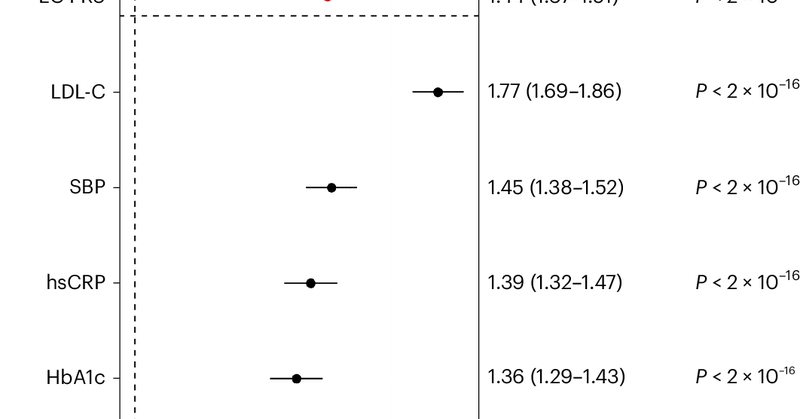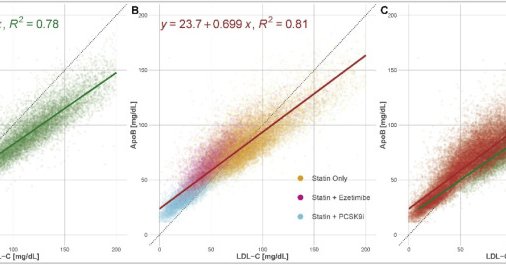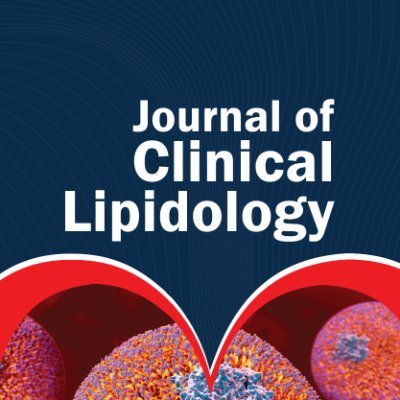
Nicholas Marston
@marstonMD
Followers
947
Following
1K
Media
97
Statuses
490
MD | MPH | Preventive Cardiologist @BrighamWomens & @HarvardMed | Clinical Trialist & Investigator @TIMIStudyGroup & @Broadinstitute | Lipids, Genetics, Trials
Boston, MA
Joined December 2012
A great team effort as always, and I especially enjoyed the collaboration with friend, colleague, and EC expert @Dr_RajatGupta on this one. @KamanuFred @TIMIStudyGroup
0
0
3
In sum, awareness of an elevated EC PRS appears actionable, because achieving very low levels of serum cholesterol mitigates its risk This highlights the potential clinical applications for EC PRS as a guide for aggressive LDL-C lowering in both primary and secondary prevention
1
0
1
...and secondary prevention PCSK9 inhibitor use in the FOURIER trial (33% RRR):
1
0
2
So what are the clinical implications of LDL-sensitivity? We hypothesized it would translate to greater benefit from aggressive LDL lowering We tested this hypothesis in 2 RCTs We found it to be true for both primary prevention statin initiation in the JUPITER trial (72% RRR!)
1
0
1
Taking the orthogonal view, individuals with high genetically mediated EC dysfunction (EC PRS) are more sensitive to LDL cholesterol concentrations, with up to twice the risk of CAD for a given level of LDL-C:
1
0
1
Notably, the EC PRS axis of risk is dependent on the concentration of LDL cholesterol When LDL-C concentration is sufficient, the EC axis is a significant contributor to CAD risk Yet when LDL-C is very low (~50 mg/dl), the EC axis of risk becomes immaterial
1
0
1
The EC PRS provides an independent axis of CV risk that is not currently captured in standard risk assessment Its strength of association with CAD is on par with that of established axes of CV risk
1
0
1
Now out in @NatureMedicine, we developed an Endothelial Cell PRS for CAD that: 1) Quantifies a currently immeasurable axis of CAD risk 2) Identifies individuals who are LDL-sensitive 3) Establishes which Pts will have greatest CV benefit from early & aggressive lipid lowering
1
5
17
A big thanks to @dan_soffer for leading this effort, it was fun to collaborate with such a great team! @CBallantyneMD @jpenamd @SethShayMartin @ThanassoulisMD @carolkirkpat3 @giorgio_melloni @nationallipid @LipidJournal @TIMIStudyGroup
1
0
9
To summarize, apoB is a precise, accurate, and well-validated measure that provides information not available on standard lipid panels Incorporation of apoB into clinical practice identifies patients at higher CV risk than appreciated who may warrant intensification of therapy
1
1
4
->Regarding goals, we used evidence from untreated populations and from RCTs of individuals treated with LLTs to provide the following apoB thresholds at varying levels of risk: ->If apoB remains >70 for high risk or >60 for very high risk, intensification of Rx is recommended
1
1
1
->What about patients with discordantly high apoB? ->These patients are at greater risk than appreciated by LDL-C alone & warrant intensification of lipid lowering therapy ->In current practice, most of these patients are being missed, as LDL-C is "at goal" & apoB isn't checked
1
1
1
->As a result, discordance between apoB and LDL-C (or non-HDL-C) is common ->When discordance is present, apoB is the strongest predictor of ASCVD risk, followed by non-HDL-C, with LDL-C being the least predictive of the 3 measure ->Discordance w/ low apoB > w/ high apoB...
1
1
1
->LDL-C only measures the cholesterol on LDL particles ->Non-HDL-C measures the cholesterol on all atherogenic particles ->ApoB measures the # of all atherogenic particles ->These are highly correlated measures, but apoB can vary by 30-40 mg/dl at a given level of LDL-C...
1
1
1
->ApoB is the main structural protein found on all atherogenic lipoproteins ->There is a single apoB molecule found on each atherogenic lipoprotein: LDL, VLDL, Lp(a), etc ->Thus, apoB is a direct measure of the circulating burden of atherogenic lipoprotein particles
1
1
1
Honored to be a part of the @NationalLipid Association's Expert Clinical Consensus on the Role of ApoB in the Clinical Management of Cardiovascular Risk in Adults. When should we be checking apoB? How low should we go? See link and thread below... https://t.co/lYq6RA81J8
lipidjournal.com
Summary of key points
2
4
11
Role of apolipoprotein B in the clinical management of cardiovascular risk in adults: An Expert Clinical Consensus from the National Lipid Association - Journal of Clinical Lipidology @nationallipid
https://t.co/bXAOK0Xtej
lipidjournal.com
Summary of key points
1
14
45
Our Expert Clinical Consensus was just released providing an overview of the physiologic and clinical considerations regarding the role of apoB measurement to guide clinical care based on the available scientific evidence and expert opinion @dan_soffer @marstonMD @CBallantyneMD
Role of apolipoprotein B in the clinical management of cardiovascular risk in adults: An Expert Clinical Consensus from the National Lipid Association - Journal of Clinical Lipidology @nationallipid
https://t.co/bXAOK0Xtej
0
11
29
Role of apolipoprotein B in the clinical management of cardiovascular risk in adults: An Expert Clinical Consensus from the @nationallipid @LipidJournal @dan_soffer @CBallantyneMD @jpenamd @SethShayMartin - 👏 https://t.co/HNBOsvgFzz Highlights 👉 ➡️ApoB
lipidjournal.com
Summary of key points
3
16
53





